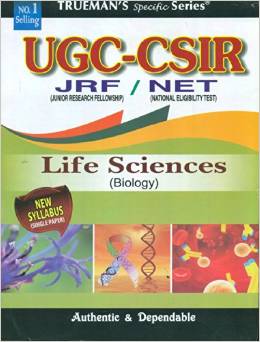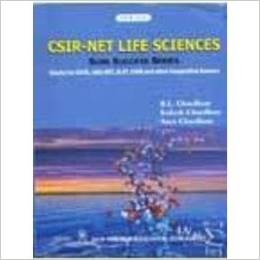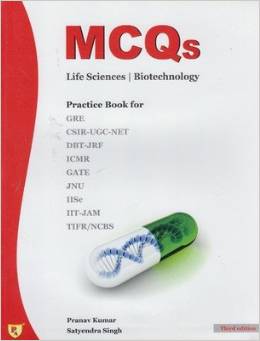| Re: CSIR NET in life sciences minimum marks for qualifying
CSIR provides Junior Research Fellowship in various fields of Science & Technology and Medical Sciences.
The Selection for award of JRF is made on the basis of a competitive written test called the (NET), conducted by CSIR at national level and consisting of two papers.
Paper – 1 is objective type consisting of Part (A) general nature and part (B) is subject type. It tests the mental ability and broad awareness of scientific knowledge.
You may choose the second paper from amongst
Chemical Sciences
Earth, Atmosphere, Ocean and Planetary Sciences
Life Sciences
Mathematical Sciences
Physical Sciences.
For the second paper you will need to give short descriptive answers.
Eligibility Criteria for CSIR UGC NET:
Candidates should have completed 4 years program / B.E / B.Tech / B.Pharma / MBBS/ Integrated BS-MS/M.Sc or equivalent degree with at least 55% marks for general and OBC (50% for SC/ST candidates, physically and visually handicapped candidates).
Minimum 55% marks after qualifying the National Eligibility Test with MSc or equivalent degree.
Paper Pattern for CSIR UGC NET:
(i) Life Sciences
(ii) Earth, Atmospheric, Ocean and Planetary Sciences
(iii) Mathematical Sciences 200
(iv) Chemical Sciences
(v) Physical Sciences
(vi) Engineering Sciences
SYLLABUS FOR LIFE SCIENCES
1. MOLECULES AND THEIR INTERACTION RELAVENT TO BIOLOGY
A. Structure of atoms, molecules and chemical bonds.
B. Composition, structure and function of biomolecules (carbohydrates, lipids, proteins, nucleic acids and vitamins).
C. Stablizing interactions (Van der Waals, electrostatic, hydrogen bonding, hydrophobic interaction, etc.).
D. Principles of biophysical chemistry (pH, buffer, reaction kinetics, thermodynamics, colligative properties).
E. Bioenergetics, glycolysis, oxidative phosphorylation, coupled reaction, group transfer, biological energy transducers.
F. Principles of catalysis, enzymes and enzyme kinetics, enzyme regulation, mechanism of enzyme catalysis, isozymes.
G. Conformation of proteins (Ramachandran plot, secondary, tertiary and quaternary structure; domains; motif and folds).
H. Conformation of nucleic acids (A-, B-, Z-,DNA), t-RNA, micro-RNA).
I. Stability of protein and nucleic acid structures.
J. Metabolism of carbohydrates, lipids, amino acids, nucleotides and vitamins.
2. CELLULAR ORGANIZATION
A. Membrane structure and function: Structure of model membrane, lipid bilayer and membrane protein diffusion, osmosis, ion channels, active transport, ion pumps, mechanism of sorting and regulation of intracellular transport, electrical properties of membranes.
B. Structural organization and function of intracellular organelles: Cell wall, nucleus, mitochondria, Golgi bodies, lysosomes, endoplasmic reticulum, peroxisomes, plastids, vacuoles, chloroplast, structure & function of cytoskeleton and its role in motility.
C. Organization of genes and chromosomes: Operon, interrupted genes, gene families, structure of chromatin and chromosomes, unique and repetitive DNA, heterochromatin, euchromatin, transposons.
D. Cell division and cell cycle: Mitosis and meiosis, their regulation, steps in cell cycle, and control of cell cycle.
E. Microbial Physiology: Growth, yield and characteristics, strategies of cell division, stress response.
3. FUNDAMENTAL PROCESSES
A. DNA replication, repair and recombination: Unit of replication, enzymes involved, replication origin and replication fork, fidelity of replication, extrachromosomal replicons, DNA damage and repair mechanisms.
B. RNA synthesis and processing: Transcription factors and machinery, formation of initiation complex, transcription activators and repressors, RNA polymerases, capping, elongation and termination, RNA processing, RNA editing, splicing, polyadenylation, structure and function of different types of RNA, RNA transport.
C. Protein synthesis and processing: Ribosome, formation of initiation complex, initiation factors and their regulation, elongation and elongation factors, termination, genetic code, aminoacylation of tRNA, tRNA-identity, aminoacyl tRNA synthetase, translational proof-reading, translational inhibitors, post- translational modification of proteins.
D. Control of gene expression at transcription and translation level: Regulation of phages, viruses, prokaryotic and eukaryotic gene expression, role of chromatin in regulating gene expression and gene silencing.
4. CELL COMMUNICATION AND CELL SIGNALING
A. Host parasite interaction: Recognition and entry processes of different pathogens like bacteria, viruses into animal and plant host cells, alteration of host cell behavior by pathogens, virus-induced cell transformation, pathogen-induced diseases in animals and plants, cell-cell fusion in both normal and abnormal cells.
B. Cell signaling: Hormones and their receptors, cell surface receptor, signaling through G-protein coupled receptors, signal transduction pathways, second messengers, regulation of signaling pathways, bacterial and plant two-component signaling systems, bacterial chemotaxis and quorum sensing.
C. Cellular communication: Regulation of hematopoiesis, general principles of cell communication, cell adhesion and roles of different adhesion molecules, gap junctions, extracellular matrix, integrins, neurotransmission and its regulation.
D. Cancer: Genetic rearrangements in progenitor cells, oncogenes, tumor suppressor genes, cancer and the cell cycle, virus-induced cancer, metastasis, interaction of cancer cells with normal cells, apoptosis, therapeutic interventions of uncontrolled cell growth.
E. Innate and adaptive immune system: Cells and molecules involved in innate and adaptive immunity, antigens, antigenicity and immunogenicity. B and T cell epitopes, structure and function of antibody molecules, generation of antibody diversity, monoclonal antibodies, antibody engineering, antigen-antibody interactions, MHC molecules, antigen processing and presentation, activation and differentiation of B and T cells, B and T cell receptors, humoral and cell-mediated immune responses, primary and secondary immune modulation, the complement system, Toll-like receptors, cell-mediated effector functions, inflammation, hypersensitivity and autoimmunity, immune response during bacterial (tuberculosis), parasitic (malaria) and viral (HIV) infections, congenital and acquired immunodeficiencies, vaccines.
5. DEVELOPMENTAL BIOLOGY
A. Basic concepts of development: Potency, commitment, specification, induction, competence, determination and differentiation; morphogenetic gradients; cell fate and cell lineages; stem cells; genomic equivalence and the cytoplasmic determinants; imprinting; mutants and transgenics in analysis of development.
B. Gametogenesis, fertilization and early development: Production of gametes, cell surface molecules in sperm-egg recognition in animals; embryo sac development and double fertilization in plants; zygote formation, cleavage, blastula formation, embryonic fields, gastrulation and formation of germ layers in animals; embryogenesis, establishment of symmetry in plants; seed formation and germination.
C. Morphogenesis and organogenesis in animals: Cell aggregation and differentiation in Dictyostelium; axes and pattern formation in Drosophila, amphibia and chick; organogenesis – vulva formation in Caenorhabditis elegans; eye lens induction, limb development and regeneration in vertebrates; differentiation of neurons, post embryonic development-larval formation, metamorphosis; environmental regulation of normal development; sex determination.
D. Morphogenesis and organogenesis in plants: Organization of shoot and root apical meristem; shoot and root development; leaf development and phyllotaxy; transition to flowering, floral meristems and floral development in Arabidopsis and Antirrhinum.
E. Programmed cell death, aging and senescence.
6. SYSTEM PHYSIOLOGY - PLANT
A. Photosynthesis: Light harvesting complexes; mechanisms of electron transport; photoprotective mechanisms; CO2 fixation-C3, C4 and CAM pathways.
B. Respiration and photorespiration: Citric acid cycle; plant mitochondrial electron transport and ATP synthesis; alternate oxidase; photorespiratory pathway.
C. Nitrogen metabolism: Nitrate and ammonium assimilation; amino acid biosynthesis.
D. Plant hormones: Biosynthesis, storage, breakdown and transport; physiological effects and mechanisms of action.
E. Sensory photobiology: Structure, function and mechanisms of action of phytochromes, cryptochromes and phototropins; stomatal movement; photoperiodism and biological clocks.
F. Solute transport and photoassimilate translocation: Uptake, transport and translocation of water, ions, solutes and macromolecules from soil, through cells, across membranes, through xylem and phloem; transpiration; mechanisms of loading and unloading of photoassimilates.
G. Secondary metabolites - Biosynthesis of terpenes, phenols and nitrogenous compounds and their roles.
H. Stress physiology: Responses of plants to biotic (pathogen and insects) and abiotic (water, temperature and salt) stresses; mechanisms of resistance to biotic stress and tolerance to abiotic stress
7. SYSTEM PHYSIOLOGY - ANIMAL
A. Blood and circulation: Blood corpuscles, haemopoiesis and formed elements, plasma function, blood volume, blood volume regulation, blood groups, haemoglobin, immunity, haemostasis.
B. Cardiovascular System: Comparative anatomy of heart structure, myogenic heart, specialized tissue, ECG – its principle and significance, cardiac cycle, heart as a pump, blood pressure, neural and chemical regulation of all above.
C. Respiratory system: Comparison of respiration in different species, anatomical considerations, transport of gases, exchange of gases, waste elimination, neural and chemical regulation of respiration.
D. Nervous system: Neurons, action potential, gross neuroanatomy of the brain and spinal cord, central and peripheral nervous system, neural control of muscle tone and posture.
E. Sense organs: Vision, hearing and tactile response.
F. Excretory system: Comparative physiology of excretion, kidney, urine formation, urine concentration, waste elimination, micturition, regulation of water balance, blood volume, blood pressure, electrolyte balance, acid-base balance.
G. Thermoregulation: Comfort zone, body temperature – physical, chemical, neural regulation, acclimatization.
H. Stress and adaptation
I. Digestive system: Digestion, absorption, energy balance, BMR.
J. Endocrinology and reproduction: Endocrine glands, basic mechanism of hormone action, hormones and diseases; reproductive processes, neuroendocrine regulation.
8. INHERITANCE BIOLOGY
A. Mendelian principles: Dominance, segregation, independent assortment, deviation from Mendelian inheritance.
B. Concept of gene: Allele, multiple alleles, pseudoallele, complementation tests.
C. Extensions of Mendelian principles: Codominance, incomplete dominance, gene interactions, pleiotropy, genomic imprinting, penetrance and expressivity, phenocopy, linkage and crossing over, sex linkage, sex limited and sex influenced characters.
D. Gene mapping methods: Linkage maps, tetrad analysis, mapping with molecular markers, mapping by using somatic cell hybrids, development of mapping population in plants.
E. Extra chromosomal inheritance: Inheritance of mitochondrial and chloroplast genes, maternal inheritance.
F. Microbial genetics: Methods of genetic transfers – transformation, conjugation,
transduction and sex-duction, mapping genes by interrupted mating, fine structure analysis of genes.
G. Human genetics: Pedigree analysis, lod score for linkage testing, karyotypes, genetic disorders.
H. Quantitative genetics: Polygenic inheritance, heritability and its measurements, QTL mapping.
I. Mutation: Types, causes and detection, mutant types – lethal, conditional, biochemical, loss of function, gain of function, germinal verses somatic mutants, insertional mutagenesis.
J. Structural and numerical alterations of chromosomes: Deletion, duplication, inversion, translocation, ploidy and their genetic implications.
K. Recombination: Homologous and non-homologous recombination, including transposition, site-specific recombination.
9. DIVERSITY OF LIFE FORMS
A. Principles and methods of taxonomy:Concepts of species and hierarchical taxa, biological nomenclature, classical and quantititative methods of taxonomy of plants, animals and microorganisms.
B. Levels of structural organization: Unicellular, colonial and multicellular forms; levels of organization of tissues, organs and systems; comparative anatomy.
C. Outline classification of plants, animals and microorganisms:Important criteria used for classification in each taxon; classification of plants, animals and microorganisms; evolutionary relationships among taxa.
D. Natural history of Indian subcontinent: Major habitat types of the subcontinent, geographic origins and migrations of species; common Indian mammals, birds; seasonality and phenology of the subcontinent.
E. Organisms of health and agricultural importance: Common parasites and pathogens of humans, domestic animals and crops.
10. ECOLOGICAL PRINCIPLES
A. The Environment: Physical environment; biotic environment; biotic and abiotic interactions.
B. Habitat and niche: Concept of habitat and niche; niche width and overlap; fundamental and realized niche; resource partitioning; character displacement.
C. Population ecology: Characteristics of a population; population growth curves; population regulation; life history strategies (r and K selection); concept of metapopulation – demes and dispersal, interdemic extinctions, age structured populations.
D. Species interactions: Types of interactions, interspecific competition, herbivory, carnivory, pollination, symbiosis.
E. Community ecology: Nature of communities; community structure and attributes; levels of species diversity and its measurement; edges and ecotones.
F. Ecological succession: Types; mechanisms; changes involved in succession; concept of climax.
G. Ecosystem: Structure and function; energy flow and mineral cycling (CNP); primary production and decomposition; structure and function of some Indian ecosystems: terrestrial (forest, grassland) and aquatic (fresh water, marine, eustarine).
H. Biogeography: Major terrestrial biomes; theory of island biogeography; biogeographical zones of India.
I. Applied ecology: Environmental pollution; global environmental change; biodiversity-status, monitoring and documentation; major drivers of biodiversity change; biodiversity management approaches.
J. Conservation biology: Principles of conservation, major approaches to management, Indian case studies on conservation/management strategy (Project Tiger, Biosphere reserves).
11. EVOLUTION AND BEHAVIOUR
A. Emergence of evolutionary thoughts: Lamarck; Darwin–concepts of variation, adaptation, struggle, fitness and natural selection; Mendelism; spontaneity of mutations; the evolutionary synthesis.
B. Origin of cells and unicellular evolution: Origin of basic biological molecules; abiotic synthesis of organic monomers and polymers; concept of Oparin and Haldane; experiment of Miller (1953); the first cell; evolution of prokaryotes; origin of eukaryotic cells; evolution of unicellular eukaryotes; anaerobic metabolism, photosynthesis and aerobic metabolism.
C. Paleontology and evolutionary history: The evolutionary time scale; eras, periods and epoch; major events in the evolutionary time scale; origins of unicellular and multicellular organisms; major groups of plants and animals; stages in primate evolution including Homo.
D. Molecular Evolution: Concepts of neutral evolution, molecular divergence and molecular clocks; molecular tools in phylogeny, classification and identification; protein and nucleotide sequence analysis; origin of new genes and proteins; gene duplication and divergence.
E. The Mechanisms: Population genetics – populations, gene pool, gene frequency; Hardy-Weinberg law; concepts and rate of change in gene frequency through natural selection, migration and random genetic drift; adaptive radiation and modifications; isolating mechanisms; speciation; allopatricity and sympatricity; convergent evolution; sexual selection; co-evolution.
F. Brain, Behavior and Evolution: Approaches and methods in study of behavior; proximate and ultimate causation; altruism and evolution-group selection, kin selection, reciprocal altruism; neural basis of learning, memory, cognition, sleep and arousal; biological clocks; development of behavior; social communication; social dominance; use of space and territoriality; mating systems, parental investment and reproductive success; parental care; aggressive behavior; habitat selection and optimality in foraging; migration, orientation and navigation; domestication and behavioral changes.
12. APPLIED BIOLOGY:
A. Microbial fermentation and production of small and macro molecules.
B. Application of immunological principles (vaccines, diagnostics). tissue and cell culture methods for plants and animals.
C. Transgenic animals and plants, molecular approaches to diagnosis and strain identification.
D. Genomics and its application to health and agriculture, including gene therapy.
E. Bioresource and uses of biodiversity.
F. Breeding in plants and animals, including marker – assisted selection.
G. Bioremediation and phytoremediation.
H. Biosensors.
13. METHODS IN BIOLOGY
A. Molecular biology and recombinant DNA methods: Isolation and purification of RNA , DNA (genomic and plasmid) and proteins, different separation methods; analysis of RNA, DNA and proteins by one and two dimensional gel electrophoresis, isoelectric focusing gels; molecular cloning of DNA or RNA fragments in bacterial and eukaryotic systems; expression of recombinant proteins using bacterial, animal and plant vectors; isolation of specific nucleic acid sequences; generation of genomic and cDNA libraries in plasmid, phage, cosmid, BAC and YAC vectors; in vitro mutagenesis and deletion techniques, gene knock out in bacterial and eukaryotic organisms; protein sequencing methods, detection of post-translation modification of proteins; DNA sequencing methods, strategies for genome sequencing; methods for analysis of gene expression at RNA and protein level, large scale expression analysis, such as micro array based techniques; isolation, separation and analysis of carbohydrate and lipid molecules; RFLP, RAPD and AFLP techniques
B. Histochemical and immunotechniques: Antibody generation, detection of molecules using ELISA, RIA, western blot, immunoprecipitation, floweytometry and immunofluorescence microscopy, detection of molecules in living cells, in situ localization by techniques such as FISH and GISH.
C. Biophysical methods: Analysis of biomolecules using UV/visible, fluorescence, circular dichroism, NMR and ESR spectroscopy, structure determination using X-ray diffraction and NMR; analysis using light scattering, different types of mass spectrometry and surface plasma resonance methods.
D. Statistical Methods: Measures of central tendency and dispersal; probability distributions (Binomial, Poisson and normal); sampling distribution; difference between parametric and non-parametric statistics; confidence interval; errors; levels of significance; regression and correlation; t-test; analysis of variance; X2 test;; basic introduction to Muetrovariate statistics, etc.
E. Radiolabeling techniques: Properties of different types of radioisotopes normally used in biology, their detection and measurement; incorporation of radioisotopes in biological tissues and cells, molecular imaging of radioactive material, safety guidelines.
F. Microscopic techniques: Visulization of cells and subcellular components by light microscopy, resolving powers of different microscopes, microscopy of living cells, scanning and transmission microscopes, different fixation and staining techniques for EM, freeze-etch and freeze-fracture methods for EM, image processing methods in microscopy.
G. Electrophysiological methods: Single neuron recording, patch-clamp recording, ECG, Brain activity recording, lesion and stimulation of brain, pharmacological testing, PET, MRI, fMRI, CAT .
H. Methods in field biology: Methods of estimating population density of animals and plants, ranging patterns through direct, indirect and remote observations, sampling methods in the study of behavior, habitat characterization-ground and remote sensing methods.
I. Computational methods: Nucleic acid and protein sequence databases; data mining methods for sequence analysis, web-based tools for sequence searches, motif analysis and presentation.
|


